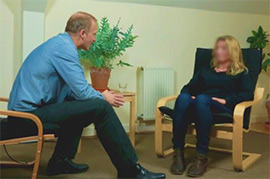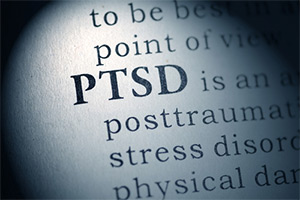You’re terrified, scared witless. It feels like you’re about to die! How will it ever be alright? How will you survive this? You feel traumatized not by a past experience, but by the prospect of a future one.
Imagination is so powerful.
Occasionally I get a traumatized client who hasn’t actually had a traumatic experience. But they’re still suffering because they’ve traumatized themselves through their imagination of some future event.
One thing I do when a client comes to me with such a fear, is to go into extremely calm and objective detail about what will likely happen.
Prefer to watch instead?
For example, if a client has a fear of flying but has never in their life actually flown, I will talk in depth about what’s going to happen during the flight. That way they can be prepared, little is unexpected, and their stress levels are lower. A part of them will be thinking “ah Mark said this would happen!”
The audio below is taken from a Q&A session held during our Rewind Technique course. And even if you haven’t taken the course, this may be helpful, as I talk about how to use the technique for clients with a fear of flying and fear of public speaking as well.
Transcript
Amanda says, “Hi. I’m confused.” I love it when people start a sentence like that. “Hi. I’m confused about rewind and the previously unexperienced scenario such as a fear of flying where no flights have been taken before. Do you get them to rewind their imagined horror story or do you get them to rewind a positive scenario that you’ve described in the initial part of the session or rewind their negative imagined flight, then do some positive future rehearsal? I’ve read through several of your previously answered questions and I’m still confused. Thanks.”
Okay, hi Amanda. I suppose ninety-nine percent of the time we treat people for experiences that have actually happened, that they’ve actually had. Whether it’s an assault or a phobic memory or some other terrifying past event. Generally speaking you could have a whole sort of psycho-therapeutic career and just use rewind for things that have actually happened.
Occasionally though, I’ll use rewind for something that hasn’t happened such as a speech. You know, someone’s got a speech next week and they may be terrified. Maybe it’s the first public presentation they’ve done and I might describe, because I’ve got a lot of experience in giving public speeches, so I might describe the way it kind of goes.
Generally for the first couple of minutes your arousal levels are a little bit higher than they will be later on because you’re just getting into it. Then some people look friendly, some people look more blank. This happens and that happens and you switch slides and often hopefully people will laugh at some of your jokes. At the end people clap. Some people will come up to you.
I’ll describe the whole speech and then rewind them back through it and then fast forward them through it and rewind and get them to see it from the outside and get them to see themselves looking relaxed. You’re kind of doing positive future rehearsal within the rewind.
When they’re seeing themselves do it in fast forward they’re seeing themselves look relaxed, calm, approachable, and enthusiastic or whatever other characteristics you’d like to have in your public presentation.
For flying, I have done this for people who have never flown before and who are frightened at the prospect. What I will do is as you suggested, Amanda, I will describe to them the experience of flying in quite some detail.
The reason I’ll do it in quite some detail is that every bit that they then encounter of what I’ve described, they can inwardly think, “Oh, yes he said this would happen. Yes, he said this would happen.”
If they’ve envisaged some horror story, I certainly don’t discuss that or get them to visualize that. I don’t want to embed that deeper within their psyche. I won’t work on that.
The only time I did that in fact, was a guy who had been on a flight and he’d taken some LSD. He’d had a bad trip on his flight and he had hallucinated the plane was crashing. He was screaming and yelling and of course it wasn’t. After that he found he couldn’t get back on to another flight because he had experienced a catastrophic plane crash through the REM state, through this LSD trip that he had taken. I did rewind that.
Boring the fear out of them
If someone’s never flown before and they have some made up horror thing, I won’t kind of go there. I’ll explain to them exactly what happens in the boring-est detail. You know, you travel to the airport. You start seeing signs for the airport. I might even describe packing, making sure they’ve got their passport. You know?
You’ll arrive at the airport. You’ll park or you’ll get off the bus or whatever. You’ll find the terminal you’re flying from. You’ll stand in line to check in. You’ll go through security. You’ll wait around in departures.
There will be shops and stuff, a lot of families and other people around. You’ll have a call to go on to the plane through the tannoy. You’ll find your seat on the plane. You’ll go through that sort of tin kind of tunnel thing on to the plane.
You get on to the plane. There’ll be someone greeting you there. You’ll find your seat. There’ll be people milling around. You’ll sit down. You’ll put your bag in the overhead locker. You’ll fasten your seat belt.
There’ll be a safety demonstration. You’ll taxi down the runway. The engines will roar. You’ll gather speed and there’ll be a point at which you’re not sure whether you’ve quite taken off yet or not. It’ll feel quite steep but from the outside it never looks as steep as it feels from the inside.
After ten minutes you’ll level off. You’ll find your flight path. There’ll be a pinging noise which means that people can mill around again and use the toilet. There’ll be food and drinks served and sometimes there’ll be turbulence just like a boat on the sea. You’ll notice that and sometimes it might even feel dramatic, but from half a mile away it looks as if the plane’s entirely smooth.
I’ll describe the whole thing. Sometimes you’ll be bored. Sometimes you’ll forget that you’re on a plane if it’s a long flight, et cetera, et cetera. Then I’ll describe coming in to land and the whole thing in quite some detail. The template is in there. This isn’t done hypnotically. I’ll just talk at them.
Using the imagination to remove the emotion
Then I’ll describe, and I’ll suggest that they can close their eyes and they can in a few moments just rewind through that whole experience, what it’s like to go back in time through that experience they haven’t had yet, but they’ve had it because I’ve described it to them.
Then I’ll get them to fast forward through it and suggest that time can fly when you’re on a plane, and get them to see it from the outside and rewinding and fast forwarding, and rewinding and fast forwarding until I’ve stripped the imagined experience of any kinesthetic effect.
Then I’ll get them to really focus on where they’re going, not how they’re getting there. It’s almost as if they can have amnesia for how they get there. I’ll suggest highway hypnosis where you drive somewhere and when you arrive somewhere you don’t know how you got there and sort of link that to the flight.
It’ll be the holiday or the trip that you remember in future, not how you got there and how you got back. I might do that for the journey back as well.
That is how I would really sort of approach that. You’re rewinding the imagined scenario but not some catastrophic imagining they have of it. You’re creating a healthy and realistic template. The realistic template is nothing dramatic will happen on the flight.
That is the realistic template and you always go for reality, for realism with your client. Hopefully that’s cleared up some confusion there.










